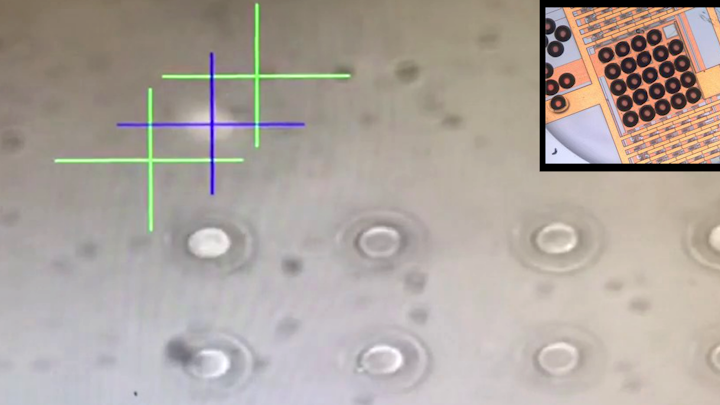Laser Catapulting is Fast, Low-cost Way to Create Microlens Arrays

A still from a video (link below) shows polymer microdisks being transferred to glass via laser catapulting. Laser catapulting can also be used to fabricate an array of microlenses directly on top of a photodetector array (inset), useful for directing more light onto the most sensitive parts of the detector. Martí Duocastella, Istituto Italiano di Tecnologia
A growing number of applications, including smartphone cameras, depend on microlens arrays to boost performance, for example by compensating for the "dead space" around detector pixels. However, although micro-optics are commercially available, they can be prohibitively expensive to fabricate and hard to add to existing devices. Even with traditional microlens fabrication methods such as photolithography, it is difficult to integrate lenses or to make very densely packed microlens arrays.
A newly developed technology called laser catapulting, developed at the Istituto Italiano di Tecnologia (Genova, Italy) could make it much easier and less expensive to fabricate micro-optics and tailor their properties such as shape or refractive power. The new laser-additive method creates microlenses each using a single laser pulse, and allows microlenses and microlens arrays to be fabricated directly on cameras or solar cells if desired.
A laser pulse removes and catapults a microdisk from a thin polymeric film and drops it onto a defined region of interest (to see the process in action, view the video at https://players.brightcove.net/76009408001/default_default/index.html?videoId=6047517250001). The polymer in the microdisk is then heated so it can thermally reflow, allowing capillary forces to shape the microdisk into a round lens. Changing the shape of the laser beam allows fabrication of microlenses with different focusing properties or shapes, such as rectangular, triangular, or circular.
After studying the relationship between the laser beam shape and the resulting microdisks, the researchers explored the reproducibility, precision, and accuracy of their technique. Their analysis showed that the method could be used to reproducibly produce microlenses with radii between 50 and 250 μm and very high smoothness. Measuring the optical properties of the microlenses and the light collection capabilities of microlens arrays made with the technique showed that these micro-optics exhibited diffraction-limited performance.
The researchers say that laser catapulting could be combined with fast laser beam shaping methods for on-the-fly control of optical performance and shape of individual microlenses within an array.
Applications in high-speed imaging
The researchers aim to use the process to fabricate microlenses on top of photodetector arrays so they can develop a high-speed 3D microscopy system to characterize very fast biological processes, such as neuronal communications or virus trafficking. The microlenses will increase the light-collecting efficiency of the photodetectors and thus decrease imaging time.
(Source: https://www.osa.org/en-us/about_osa/newsroom/news_releases/2019/inexpensive_simple_fabrication_method_poised_to_ex/?utm_source=osaHome&utm_medium=slider&utm_term=sliderlink&utm_content=OMEx%20Simp%20Fab)
